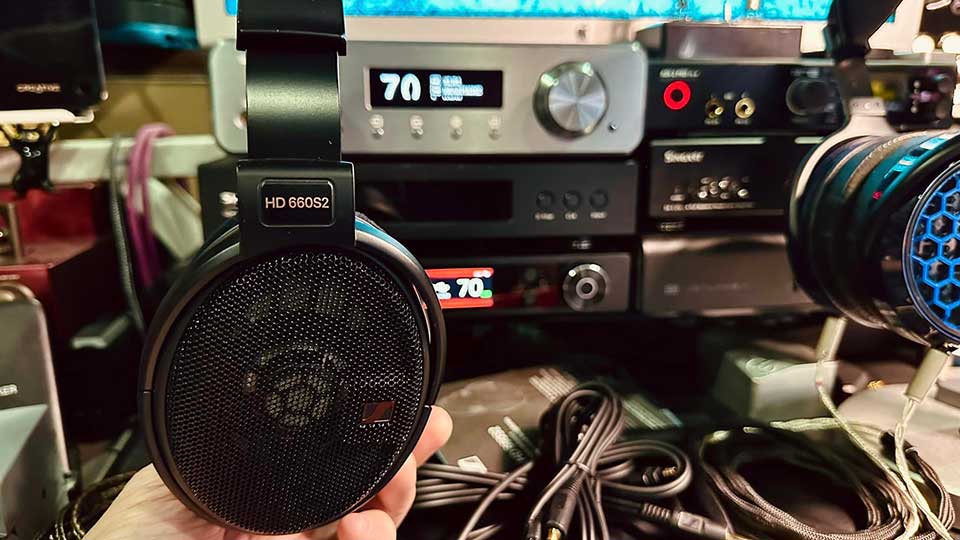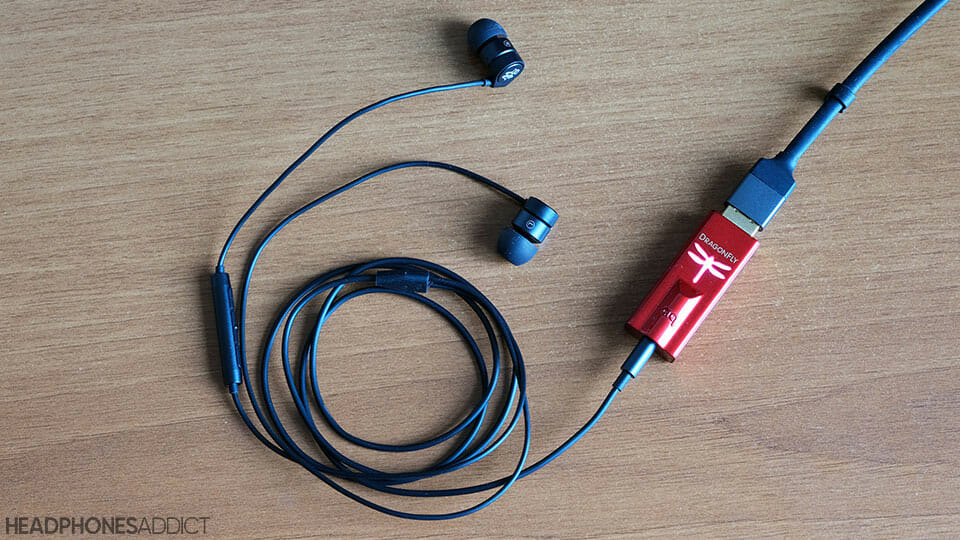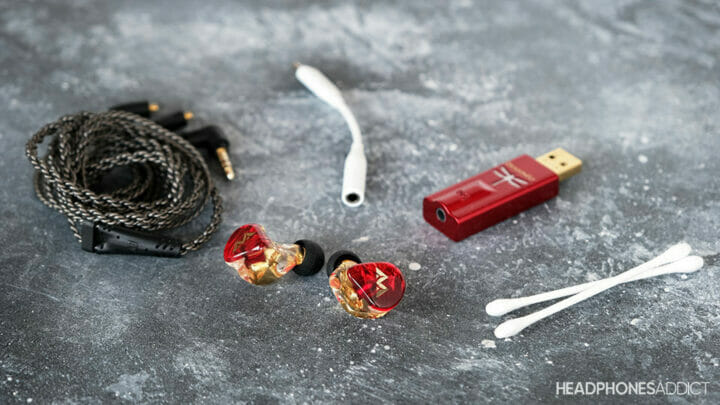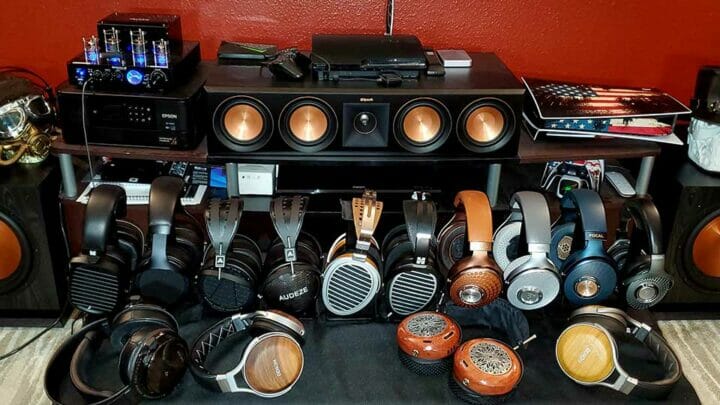DAC or digital-to-analog converter transforms digital information into an analog signal your headphones can understand.
If external DACs were once an essential part of high-quality audio, modern tech made them almost obsolete.
- Do you still need an external DAC?
- What kind of problems does it solve?
Here’s everything you need to know.

What is a DAC?
DAC stands for “Digital-to-Analog Converter” and is responsible for reconstructing digital 1’s and 0’s into an analog signal your headphones and speakers can play.
Remember the children’s dot puzzles that you had to connect to reveal the image? That’s pretty much what DAC is doing, only that the final image is sound waves. We’ll go into more details later.
DAC is a part of all devices that send a digital audio signal to headphones, speakers, and amplifiers. But if you’re using vinyl or cassettes, you don’t need a DAC because the audio signal is already analog.

DAC vs. ADC comparison
ADC stands for analog-to-digital converter, and it does the opposite function of DAC. It turns analog audio signal to digital.
Every audio signal is analog first before digital. You make the conversion with ADC.
Where is it used?
For example, ADC is a part of every microphone. When the microphone picks up the sound, it creates an analog audio signal. Then ADC transforms it into a digital signal that can be stored and used by your smartphone.
How Does a DAC Work?
DAC, or digital to analog converter, transforms digital 1’s and 0’s into electrical current values that speakers can later convert into sound.
To fully understand the process, you must first understand how the analog signal gets stored digitally (or how ADC works).
Picture the analog audio signal as sound waves. To store the shape of those waves digitally, you can “draw” dots on the wave line and remember the position of the dots. The latter is stored in a series of 1’s and 0’s.

However, perfectly capturing an analog signal would require infinite dots, resulting in an infinitely big audio file. So, to keep the size low, you must decide how many “dots” you want to draw.
This is where bit depth and sample rate come in.
A higher sample rate means you can “draw” more dots on the signal wave (horizontal axis), whereas higher bit depth ensures you draw your dots as close to the signal wave as possible (vertical axis).
It takes at least 16-bit depth and 44.1kHz sample rate to ensure humans don’t distinguish between an analog and digital audio file.
The DAC takes the information about the position of those “dots” and tries to “re-draw” the soundwave.
While that sounds like a straightforward process, not all DACs output the same sound quality. The most common problems are unwanted white or static noise or changes in pitch and timbre.
Quantization error and rounding-off
Since the analog signal is so detailed, your “dots are rarely directly on the line, which means that an analog audio signal reconstructed from a digital file will never be identical to the original signal.
That’s called quantization error. It manifests in a lower signal-to-noise ratio, reduced dynamic range, changes in pitch and timbre, and audible white noise. It occurs in both ADCs and DACs.
On the DAC side, you also have something called “rounding off”. Depending on the bit depth value, DAC can more or less accurately determine the voltage of the soundwave at a specific “dot”.

When that dot is between the two bit values, DAC has to move it up or down, whichever bit value is the nearest (it rounds it off).
These errors get smaller with higher bit depth values as the “dots” are closer to the signal wave line.
Electromagnetic radiation
When digital data goes into a DAC chip that converts and reconstructs it into an analog electrical signal, it becomes vulnerable to outside electromagnetic interference (EMI).
Often, the EMI creeps into your audio right inside a computer case filled with power-hungry components. That’s because audio processing components aren’t appropriately shielded.
The result is a static noise that varies in intensity.
However, most modern computers and other everyday gadgets you use to listen to music have many better-shielded components, so the EMI noise isn’t as big of an issue.
Moreover, you can experience corrupted data, which you can hear as a robotic noise or as complete silence.
Unlike analog signal, which emits white noise in the absence of data, the digital signal remains silent if there’s inefficient data for reconstruction.
There’s also a jitter and aliasing, which we will discuss later.
Do You Need a DAC?
Since all your gadgets store their data digitally, but the world around us is analog, DACs have become an essential part of every modern gadget.
Today, unless you own cassettes or vinyl records, all your audio is stored digitally:
- On your computer, laptop
- Smartphone, iPhone
- USB flash drive
- MP3 storage
- CDs, DVDs
- Audio streaming services
However, speakers and drivers inside headphones only produce music with an analog signal.
An analog signal is a fluctuating voltage in positive-negative cycles, which makes speaker cones vibrate and produce sound (if we really simplify the process).

Therefore, every modern device needs a DAC to convert and reconstruct that voltage values as faithfully as possible. Even your Bluetooth headphones have one built-in.
The main question is, how good of a DAC do you need? The latter’s quality has improved immensely over the last decade, so you might be okay with the one you already have.
It all comes down to what type of listener you are and whether you own high-end audio equipment.
For casual users
Errors that occur using a standard modern built-in DAC are negligible for a casual user.
Most casual listeners don’t carefully analyze the audio, so tiny distortions and background noise go unnoticed. In other words, most people are undemanding users. Therefore, built-in DAC works just fine for them.
For audiophiles
If you’re a demanding listener where every little detail matters, you might justify investing in a better high-quality DAC.
Of course, the better audio equipment you have (high-end headphones, speakers, and amplifiers), the more you can hear errors caused by a lower-quality DAC.

- Even then, cashing out hundreds of dollars for a DAC might be overkill. The ones below $200 should provide everything you need.
- Paying more than that only ensures compatibility with more audio formats, like DSD (Direct Stream Digital), MQA (Master Quality Audio), PCM (Pulse Code Modulation), etc. Moreover, more expensive DACs support 32-bit depth and 384kHz sample rates. While theoretically superior, that only gives you details that are impossible to detect with human ears.
Benefits of Using a DAC: Digital-to-Analog Converter
If you constantly hear static or distorted noise when listening to music, you might have an issue with your current built-in DAC. In this case, you will certainly benefit from an external, standalone DAC.
Here are all the benefits of replacing a bad DAC with a quality one.
Elimination of digital noise and distortion
We already covered quantization error and EMI noise above; now, let’s talk about audio jitter and audio aliasing.
An audio jitter is caused by an error in a digital clock responsible for precisely reproducing (or recording) individual samples. You still get the same number of sampling “dots” per second, but they aren’t equally placed on the signal line.
You can imagine a digital clock as a metronome. It provides timing to DAC (or ADC) when to reproduce (or record) a sample.
Jitter manifests as a slight change in the timing of the music (especially in higher frequencies) or as an audible clicking noise.
Thankfully, jitter isn’t that much of an issue in modern equipment. However, it more often occurs in older equipment or on CDs.
Better DACs will have a more accurate digital clock, but that will only matter to owners of high-end audio setups that can make the jitter obvious.
Note that jitter most commonly occurs during analog-to-digital conversion and that no digital recording exists without some jitter baked in.

Audio aliasing, on the other hand, happens when there aren’t enough samples to reconstruct a frequency soundwave accurately. That results in DAC generating a different frequency at different loudness.
The Nyquist theorem suggests that to sample a specific frequency, you need twice as high a sample rate. Therefore, to sample 20kHz frequency, you need at least a 40kHz sample rate.
So, a standard sample rate of 44.1kHz is more than enough to avoid audio aliasing.
Meaning that either aliasing occurred during AD conversion or you accidentally set your audio settings to sample lower than 44.1kHz.

Improved sound quality
If you’re rocking an old gadget, chances are it has a mediocre DAC built inside. Those are prone to creating background noise and jitter and aren’t adequately shielded against EMI.
A more modern DAC minimizes the chance of hearing any of those issues.
Furthermore, modern DAC can decode audio in 24-bit depth and 96kHz sample rate, ensuring no detail will go missing.
Also, the higher the bit depth, the better the dynamic range (difference between the loudest and the quietest part of the song) and signal-to-noise ratio (SNR).
SNR is described in decibels, and it tells the difference between the loudest possible sound and the audible noise due to quantization error. So, with SNR at 100dB, the loudest sound is 100dB higher than the noise.
However, music isn’t playing at a constant 100dB, so the higher the SNR, the more headroom you have before hearing the noise.
16-bit depth has an SNR of 96dB, whereas 24-bit depth has an SNR of 144dB. The latter sounds excessive, but it can help when listening to classical music, which constantly switches from quiet to grandiose passages.

Precision and accuracy
A better DAC than your standard built-in one can theoretically output a more faithful analog signal with little to no errors.
However, the question is whether you have good enough headphones or speakers to hear the difference. And, of course, if your ears can even detect it (the older we get, the worse our hearing is).
What about compatibility with different devices?
Remember that DACs need digital input to receive the info in 1’s and 0’s. So, make sure the device you want to plug in has an appropriate output.
A typical connection is the USB port and optical TOSLINK. More expensive DACs also have a coaxial and Bluetooth receiver or more exotic inputs like IIS and AES.
Typical outputs on DACs are RCA, XLR, or 3.5mm/6.35mm.

Factors to Consider When Buying a DAC
If you experience issues with your audio, like hearing unwanted noise, clicking sounds, or changes in pitch, getting an external DAC is a viable solution.
Here are a few things to consider before spending your hard-earned money.
Audio quality
Buying a better DAC will clear up your audio, making some details slightly more apparent. But most importantly, it will reduce the background noise to inaudible levels.
The latter will be most apparent if you tend to listen to audio at higher volumes when noise and distortion become louder and more obvious.
Depending on how demanding of an audio enthusiast you are, you can select DACs from different price ranges.
- DAC below $200 should resolve most of your audio issues. It will clear up the sound and offer standard inputs and outputs found in most devices.
- DAC above $200 is only reasonable if your digital audio files are in high-res formats like DSD or MQA. It is also a more reassuring buy if you plan to use it with high-end audio equipment.
Compatibility with other devices
You need to know to which device you plan to connect your new DAC. If you plan to connect it to your PC or a smartphone, the DAC needs at least a USB port.
If you’re pairing it with a TV, a CD/Blu-ray player, or some other audio interface, you must search for a DAC with a TOSLINK, coaxial, or some other special inputs.
Design and aesthetics
You can buy an external DAC or a sound card for a PCI slot to plug into a PC motherboard.
External DACs can be small and inconspicuous or as big as an iPad, depending on how many input and output ports they offer.

Some are made with a classy-looking exterior you can showcase on your desk, whereas others only have a nice front panel and are meant to be sandwiched with a headphone amp.
On the other hand, a PC sound card can look plain or covered in a plastic shield to give it a more serious look. The latter is important if you’re rocking a glass side panel on your desktop.
Price
As mentioned, below $200 should offer everything in terms of optimal sound quality, whereas above $200 gives you better audio format support and more inputs and outputs.
More expensive DACs also look prettier, with LED displays and metal construction to make your setup look more professional.
Convenience
DACs vary in size. A bigger DAC is fine if you rock a big desk with lots of empty space. On the other hand, if you don’t have a lot of space, you may have to opt for a smaller DAC.
Furthermore, if you desire to use it with your wired headphones on the go (for example, connecting it with your smartphone), it has to be smaller and battery-powered.
Do you need a DAC with an amp?
You don’t necessarily need a DAC with an amp, but you do need to send a signal from your DAC to an amp.
That’s because a DAC, while it can drive your headphones, can’t drive them sufficiently. The analog signal needs a boost in power, and only then can you enjoy a loud, dynamic, and detailed sound.
To minimize the fuss around that, you can buy a DAC/amp combo.

Common Types of DACs
By now, you know there are internal and external or standalone DACs and that they come in different sizes. Let’s dive deeper into various designs and when to use them.
External DACs
External DACs are all DACs that come as separate units and are not soldered into another device.
Because they are separate units, they aren’t as affected by EMI radiation from other power-hungry components around them, like processors inside your PC or smartphone.

- They’re the only solution when you hear an audible static noise, white noise, or clicking from your onboard DAC
- Separate DAC means spending more money, having to deal with more cables, and possibly having to occupy another power socket to drive it
Built-in DACs
Since every digital device has to convert the signal to analog, they all have built-in DACs.
However, internal DACs vary in quality. Some are there only to do the basic work, whereas others make sure to avoid possible errors, have more accurate digital clocks, are better shielded against EMI, etc.
The good news is that modern DACs have improved immensely over the past decade, as sound is getting recognized as important as video for enjoying entertainment.
- Cheap, as it’s already included inside your device
- Most modern devices come with a good-quality DAC
- Most built-in DACs don’t have support for high-end audio codecs
- Some can still suffer from a higher noise floor
USB DACs
USB DACs are as big as a regular USB flash drive, which makes them an excellent solution for users with limited space and laptop owners.
They’re tiny, but don’t let that scare you away. Chips are getting smaller and smaller, so a tiny chip works equally as well, if not better, than a bigger chip ten years ago.
Another thing about USB DACs is that they usually come with an amplifier as well. AudioQuest is making the most popular ones from the DragonFly series.

- Small and portable
- Usually come as a DAC/amp combo, so you don’t need a separate amp
- Not enough power to drive headphones with an impedance over 300 ohms
- Stick out from your USB port and carry the weight of the headphone cable, so you can accidentally bend the connector or damage the USB port
Portable DACs
Portable DACs can be a USB audio dongle, a USB DAC that connects to your device with a USB extender, or a dedicated DAC/amp combo with a built-in battery in a size of a credit card.

- Dongles are a quick solution for removing the AUX port from all smartphones.
- USB DAC improves the audio from your phone’s built-in DAC
- A dedicated portable DAC/amp also improves the audio and holds the most power so that it can drive more power-hungry headphones
- Improved audio quality on-the-go
- You have to deal with changing the DAC
- Not as good as external desktop solutions
DAC vs. amp
DAC transforms the digital audio data into an analog one, which is then sent to the amp to amplify it.
Both are an essential part of your audio system if you want your headphones (let alone room speakers) to produce accurate sound with sufficient loudness.
Frequently Asked Questions (FAQ)
What exactly does a DAC do?
DAC takes a digital signal of 1’s and 0’s and converts them into an analog signal. In terms of audio, DAC takes digital music data from your digital music files and creates an analog signal that your headphones (or speakers) can play to produce sound.
Does DAC improve sound quality?
External DAC can improve sound quality if your built-in DAC produces audible noise and clicking sounds. Fortunately, most modern DACs already built into your gadgets work great, so you might not even notice the difference in sound quality if you buy an expensive DAC.
Do I need a DAC or just an amp?
If you have a modern built-in DAC, you just need an amp. If you don’t hear audible static or white noise or clicks during music playback, your existing DAC works just fine. Therefore, to get better sound quality, get a better amp instead.
Is DAC necessary?
DAC is necessary since no headphone driver or room speaker can understand digital signals. A digital signal needs to be converted into analog, which is precisely what DAC does.
Will a DAC make the music louder?
DAC won’t make the music louder by itself, but it will ensure your high-resolution audio files have a higher dynamic range and signal-to-noise ratio.
Conclusion
Analog data is great and all, but it is highly inefficient for long-term storage. That’s why everything nowadays is stored digitally.
Because of that, digital to analog converters are a crucial part of all gadgets we own. And the better they are, the more faithfully they can reconstruct the signal back to analog.
While theoretically, there’s always more you can squeeze from a given data, modern built-in audio DACs already work well enough for most users.

From a childhood fascination with sound, Peter’s passion has evolved into a relentless pursuit of the finest headphones. He’s an audio expert with over 5 years of experience in testing both audiophile and consumer-grade headphones. Quote: “After many years, I can confidently tell which headphones are good and which are terrible.” Find his honest opinion in his reviews.



